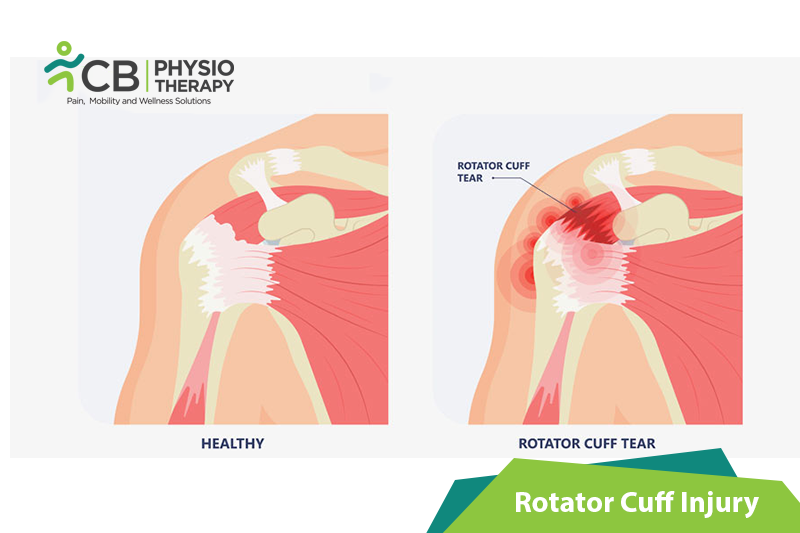
A rotator cuff is a group of muscles and tendons that surround the shoulder joint, and keep the head of the upper arm bone firmly within the shallow socket of the shoulder. A rotator cuff injury can cause a dull pain in the shoulder, which often worsens when the patient sleeps on the involved side. Rotator cuff tear is the leading cause of shoulder pain and shoulder-related disability.
The symptoms of rotator cuff injury depend upon the severity of the injury. Individuals with rotator cuff injury can suffer from:
Rotator cuff tears can be caused due to many reasons, few of them are:
Pathology:
Rotator cuff injury is the term used to describe the damage of tendons due to aging, degeneration, or excessive pressure, irritating the adjacent bursa known as subdeltoid or subacromial bursitis or gradual detachment of the bone tendons from the head of the humerus.
Physical examination:
The physiotherapist checks for the yellow flags for shoulder injuries like depression fear avoidance beliefs. pain syndromes, psychological illness. The physical examination includes inspection and palpation, range of motion testing, strength testing, and special tests. Active and passive range of movements such as forward flexion, abduction, and internal/external rotation at 0° and 90° are checked. Rotator cuff injuries can lead to loss of active range of motion although the passive range of motion is often preserved. Strength can be tested using a portable hand-held dynamometer, as rotator cuff tears are often present with shoulder weakness.
Tests for Subscapularis:
Tests for Supraspinatus and Infraspinatus:
Test for Teres minor:
Hornblower's sign.
X-rays:
X-rays are used to exclude sclerosis and osteophyte formation on the acromion. Although
X-rays can't show rotator cuff tear, they can visualize bone spurs or other causes of pain like arthritis.
Magnetic resonance imaging (MRI):
Magnetic resonance imaging (MRI) uses radio waves and a strong magnet, to display all structures of the shoulder in detail.
Ultrasound:
Ultrasound uses sound waves to produce images of structures within the body, particularly soft tissues like muscles and tendons. It allows a provider to assess the structures of the shoulder during movement. It also allows comparison between the affected shoulder and an unaffected shoulder.
Medication: Nonsteroidal anti-inflammatory drugs (NSAIDs), steroid injections, etc.
NOTE: Medication should not be taken without the doctor's prescription.
Surgery:
Many different types of surgeries are available for rotator cuff injuries, required only when conservative treatment fails. These surgeries include:
Cold therapy or ice therapy are used to decrease pain, and swelling and also help to relieve soreness.
Heat therapy or thermotherapy helps to increase circulation and release the toxins from the affected area.
Ultrasound therapy is used near the inflamed area of the rotator cuff, to decrease pain and inflammation.
Transcutaneous electrical stimulation (TENS):
Transcutaneous electrical stimulation (TENS) helps reduce pain and muscle tension in the scapular and shoulder areas to promote mobility.
Iontophoresis:
Iontophoresis is a procedure used to drive medication to the targeted tissue. It provides pain relief with modalities and helps to maintain motion.
Sling or immobilisation:
A sling may be recommended for short-term comfort, but if used for a longer duration might cause shoulder stiffness. The elbow, forearm, and wrist should be used to strengthen them, especially during long immobilization.
Kinesio taping for pain-free ROM and joint stability is recommended.
Passive and active range of motion:
A gentle, passive range-of-motion program is recommended to prevent stiffness and maintain range of motion during the resting period. Exercises, for the anterior, inferior, and posterior shoulder, should be part of the rehab program.
Codman exercises:
These exercises permit the patient to abduct the arm by gravity, the supraspinatus remains relaxed and does not require a fulcrum.
Strengthening Exercises:
After a painless range of motion is achieved, the patient is recommended a gentle strengthening program. Strengthening exercises gradually improve strength in the shoulder girdle by using manual resistance, elastic bands of six different colors and strengths, weights, dumbbells, or a pulley set. The program is customized according to the needs of the individual.
Mobilization:
Mobilization of the scapulothoracic joint and posterior capsular mobilization are applied to improve the shoulder range of motion.
Soft Tissue Massage:
Soft tissue massage is a hands-on technique used for muscles and ligaments, improving the flexibility in these structures. This can help open up the posture and decrease any pinching or irritation on the rotator cuff muscle.
Stretching Exercises:
Stretching exercises are often indicated and applied to decrease shoulder stiffness and improve shoulder function. The physiotherapist usually focuses on improving the flexibility in the chest muscles that help move the shoulder.
Plyometric training:
Plyometric training includes catching & throwing a weighted ball. Agility training includes deriving energy from the lower extremities, transferring it through the pelvis, and releasing it through the upper extremity.
Patients with a sedentary lifestyle can suffer from rotator cuff injury as it can lead to deconditioning of the upper body and arms strength. Stressing a weakened rotator cuff can eventually lead to a rotator cuff injury. Therefore, one should focus on strengthening training and prevent the overloading of muscles.
Select your City to find & connect with our experts regarding Physiotherapy for Rotator Cuff Injury